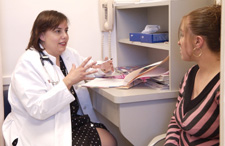|
Catholic Medical Association reviving Milwaukee area guild
Promoting church teaching among physicians, students entering the field

|
PROMOTING LIFE ISSUES — Dr. Julie Mickelson meets with a patient at St. Mary's Medical Clinic. Dr. Mickelson was the chief organizer of a May 4 Hippocratic Oath Banquet sponsored by the Milwaukee Guild of the Catholic Medical Association and Marquette University's Faculty for Life. (Catholic Herald photo by Sam Lucero)
|
By Debbie Movrich
Special to the Catholic Herald Staff
MILWAUKEE — In recent years, one of the most visible signs of life in the Milwaukee Guild of the Catholic Medical Association was the annual White Mass. The Mass was celebrated on or near Oct. 18, the feast of St. Luke, patron saint of physicians.
Dr. Robert McCabe formed the Milwaukee Guild in 1954. The guild thrived until 1968 when Pope Paul VI’s promulgation of “Humanae Vitae,” the encyclical in which he reaffirmed the church’s teaching opposing the use of artificial methods of birth control, deeply divided the organization’s general assembly and moved the president of the CMA to resign.
Once strong guilds, including the one in Milwaukee, became virtually inactive. The membership of the CMA, which at its height boasted more than 10,000 physicians and 100 guilds, dwindled to 300 members and two guilds. Over the last several decades, membership in the U.S. and Canada has topped 1,000.
The Milwaukee Guild received new life in the fall of 2003. During the national meeting of the CMA, Dr. Scott Benet decided to resuscitate the dormant Milwaukee Guild. Calling on physicians strong in their Catholic faith, he gathered a small group of doctors that met in January 2004 and elected officers from among those present.
Dr. Chris Zainer, president of the Milwaukee Guild of the CMA, said the resurgence of the group might be due to the effects people have seen from devaluing human life.
“I think people have seen the destruction that has occurred from not accepting the church’s teachings. People thought that contraception would lead to stronger marriages. Since the pill came into this country we have had a dramatic increase in divorce, unstable marriages, and abortions,” she said.
She added that other “negative social indicators” in the post-pill U.S. included STDs, child abuse, and abuse toward women.
“While intuitively it would seem like contraception would lead to less of these problems, it hasn’t. People are saying, ‘Well does that mean we need more and better contraception?’ More and better doesn’t make us happier or more stable,” Zainer said.
She noted that younger medical students see what didn’t work in their parents’ generation.
“Maybe these assumptions of what we thought would be good isn’t good — they then become more open to the teachings of the church,” Zainer said.
One of the first priorities was to focus upon prayer. The guild approached different hospital chaplaincy services and requested that chaplains offer masses for intentions of the CMA and its members’ patients. Five Milwaukee hospitals responded and currently offer Mass once a month in which those intentions are included.
Another activity offered by the Milwaukee Guild was the co-sponsorship of events supporting the value of life. The May 4, 2005 Hippocratic Oath banquet put on by the guild and the Marquette University Faculty for Life is a recent example. Historically, the traditional Hippocratic Oath had never before been offered or said in Milwaukee.
“The idea of the Hippocratic Oath banquet was not only the saying of the vows but to also be able to bring all the students together to give them encouragement and support because they (Students for Life) are really getting zero support from the administration at the medical college (Medical College of Wisconsin),” according to Dr. Julie Mickelson, chief organizer of the banquet.
Student CMA member Melissa Themar said that the link between the Hippocratic Oath and her faith was evident.
“What attracted me to the banquet was that we would, as graduating medical students about to become doctors and heading out into our respective fields, be taking the oath in its original form which places an emphasis on the value of life as opposed to the culture of death. Our school wasn’t offering for us to be able to take it in that form,” she said. “I think for a lot of us it meant making a commitment to ourselves and to God and to the Church that we are about Catholic values and our faith. It was important that I was able to do that in the context of my medical profession.”
While CMA members join their faith and profession, that’s not necessarily the way the medical schools teach.
“You’re taught you’re supposed to separate your spirituality from your profession. It’s supposed to be whatever the patient feels is best for himself even if you feel that morally it’s not,” Dr. Cynthia Jones-Nosacek.
An essential part of treating patients, according to Dr. Jim Linn, is truth.
“Catholic medical ethics believes there is an absolute right and absolute truth. Bringing that to people only helps them. You are compassionate but you have to give people the truth; you have to tell them what’s right and wrong, “Dr. Linn said. “They don’t have to agree with you; they can walk away, but if you don’t bring them the truth, you’re not being compassionate.”
Be An Informed Catholic!
For the rest of this week's news, visit the Catholic Herald web site.
Click here to subscribe to the Catholic Herald.
|